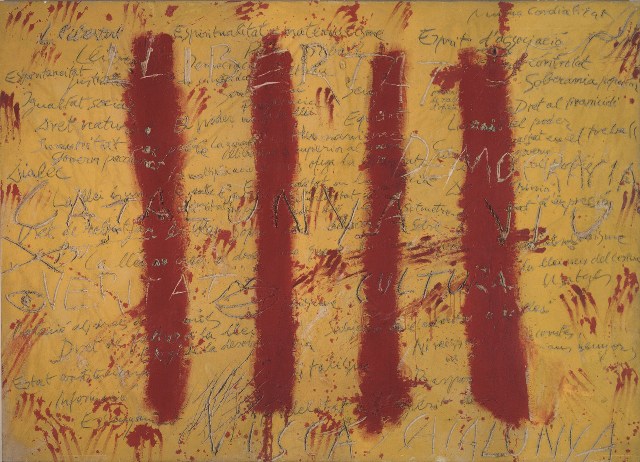The piece of the month of June 2010
THE CATALAN SPIRIT OF ANTONI TÀPIES, FROM THE MUSEUM OF CONTEMPORARY ART OF THE UNIVERSITY OF NAVARRA
Kristian Leahy Brajnovic
PhD in History
The pictorial work of the Catalan Antoni Tàpies, born in Barcelona in 1923, originates in the historical context of Informalism in the fifties, based on the recreation of the subject under minimal signs of expression, the translation of the artist's vital energy to the pictorial surface and the idea that textures and forms can cause an infinite issue of emotional effects. In this painting "The Catalan Spirit", the red bars on a yellow background show a political commitment of the artist, a cry of deep love for his land, revealing the image of a wall as a lacerated space of human scars of time and graphic mirror of a longing for freedom. On a dense yellow background, furrowed by the four blood-colored bars that refer to the epic legend of Wilfred the Hairy that originated the flag, the artist fervently expresses a manifesto of hope through a palinsext of graphics that scratch the surface of the painting as "democracy", "truth", "spirituality", "culture" or "Visca Catalunya", signs of freedom taken away during the post-war years for political reasons.
The large panel "The Catalan Spirit", measuring 200 x cm, is considered one of Tàpies' great masterpieces and, over the years, has been temporarily ceded by its previous owner, María Josefa Huarte, to form part of various retrospectives of the artist, such as those held in 1980 at the Spanish Museum of Contemporary Art, at the Serpentine Gallery in London in 1992 or in the anthological exhibition at MACBA, Museu d'Art Contemporani de Barcelona in 2004. Tàpies made very few variations on this topic, highlighting the work "Four Bars" (1972), which is part of the collection of the University Art Museum in Berkeley, California, or the paintings still in private collection: "Inscriptions and Four Bars on Burlap" and "Parchment with Four Impressions of Fingers", both made in 1971. In the first of them Tàpies transferred the pictorial phenomenon of "The Catalan Spirit" to a tapestry with the partnership the craftsman Josep Royo, and the other two were created respectively under an austere povera aesthetic by means of strings and on a support of old parchment. In the heritage of Navarra we can find other important works by Tàpies, all of them in the collection of the Museum of Contemporary Art of the University of Navarra, such as "Relleu de T inclinada" (1975), "Negro sobre Gris" (1985), "Incendi" ( 1991) and "Composició amb Cistella" from 1996.
The Catalan Spirit represents a symbolic and universal wall of division but also of paradoxical unity, reflecting a hope on the other side, in that hidden and invisible beyond that separates us from what we long for and that once torn down will save us.

Antoni Tàpies (1923). The Catalan Spirit. 1971 (Oil on panel)
Museum of Contemporary Art of the University of Navarre
